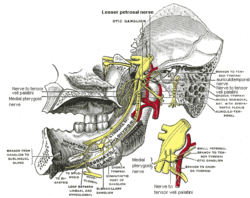Structure and Course of the Mandibular Nerve
- The mandibular nerve emerges from the lateral part of the trigeminal ganglion.
- It exits the cranial cavity through the foramen ovale.
- The motor root of the trigeminal nerve passes under the trigeminal ganglion.
- It unites with the sensory root just outside the skull.
- The nerve divides into a small anterior division and a large posterior division.
- The mandibular nerve passes between tensor veli palatini and lateral pterygoid.
- It gives off a meningeal branch and the nerve to medial pterygoid.
- The nerve has a medial side.
- The nerve immediately divides into an anterior and posterior division.
- The anterior division is smaller than the posterior division.
Clinical Relevance of the Mandibular Nerve
- The mandibular nerve supplies the sensory innervation to the mandible.
- It is involved in facial pain disorders.
- Understanding the mandibular nerve's anatomy is crucial for dental procedures.
- Damage to the mandibular nerve can result in sensory deficits in the lower face.
- The nerve's course and branches can be affected by various pathologies.
References
- Rodella et al. conducted a review on the mandibular and maxillary nerve supplies.
- The study discussed the clinical relevance of these nerves.
- The article was published in the Archives of Oral Biology.
- Burchiel proposed a new classification for facial pain, including mandibular nerve-related pain.
- The classification was published in the journal Neurosurgery.
External Links
- MedEd at Loyola provides educational resources on the mandibular nerve.
- The website offers information on gross anatomy and clinical relevance.
- The link provided leads to specific content on the mandibular nerve.
- The page includes detailed information and diagrams.
- Additional external resources may be available on the website.
In neuroanatomy, the mandibular nerve (V3) is the largest of the three divisions of the trigeminal nerve, the fifth cranial nerve (CN V). Unlike the other divisions of the trigeminal nerve (ophthalmic nerve, maxillary nerve) which contain only afferent fibers, the mandibular nerve contains both afferent and efferent fibers. These nerve fibers innervate structures of the lower jaw and face, such as the tongue, lower lip, and chin. The mandibular nerve also innervates the muscles of mastication.
| Mandibular nerve | |
|---|---|
 Mandibular division of the trigeminal nerve. | |
 Mandibular division of trigeminal nerve, seen from the middle line. The small figure is an enlarged view of the otic ganglion. | |
| Details | |
| From | Trigeminal nerve (CN V) |
| Identifiers | |
| Latin | nervus mandibularis |
| MeSH | D008340 |
| TA98 | A14.2.01.064 |
| TA2 | 6246 |
| FMA | 52996 |
| Anatomical terms of neuroanatomy | |
mandibular nerve (plural mandibular nerves)